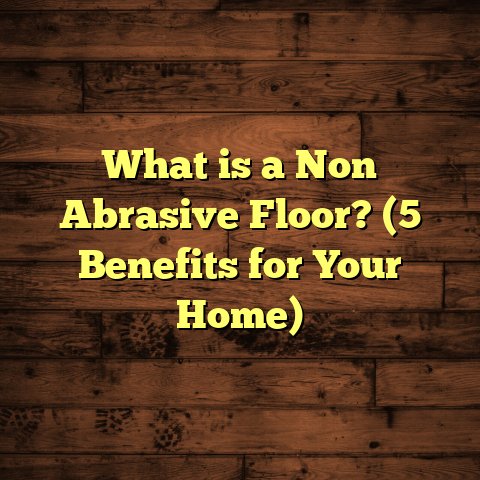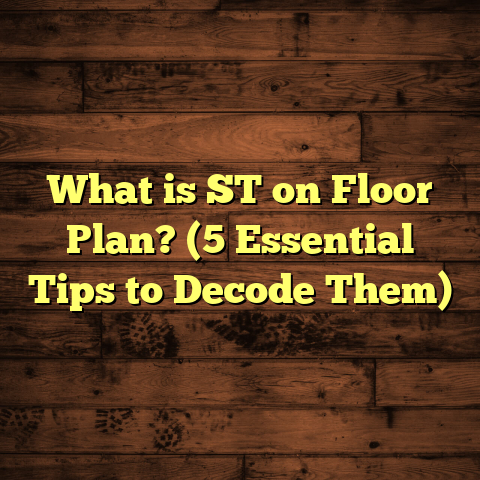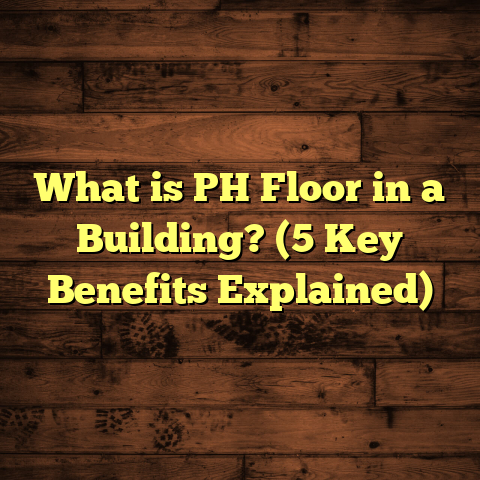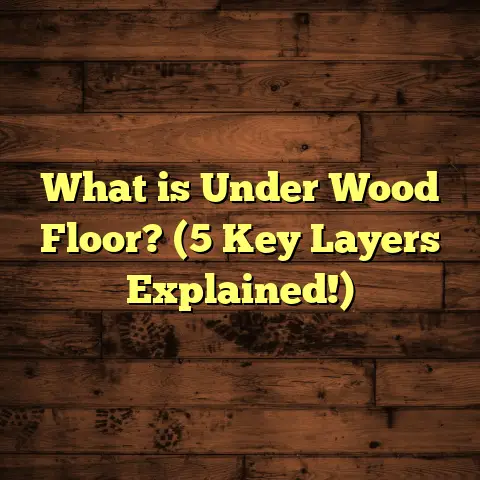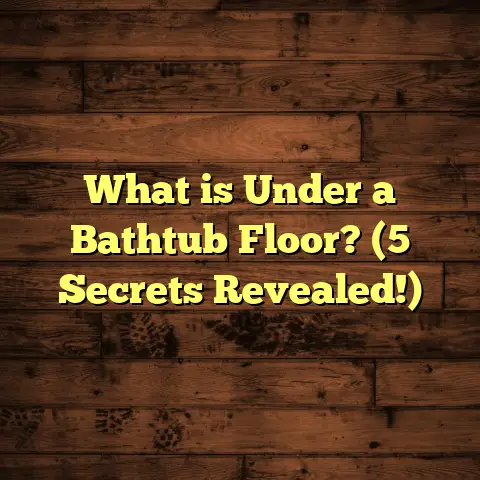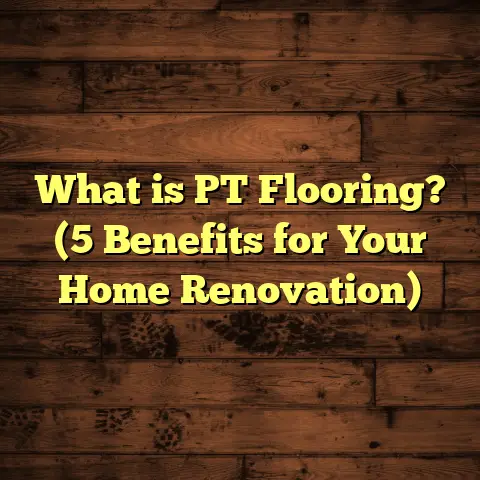What is Extreme Polymer Core Flooring? (5 Benefits You Must Know)
I had one of those “aha” moments a while back when I was helping a client choose flooring for their new home. They wanted something tough, waterproof, and stylish, but nothing seemed to check all the boxes—until I introduced them to extreme polymer core flooring. At that point, I realized many people don’t really know what this flooring is or why it’s becoming so popular. So, let me share everything I’ve learned about it, including its benefits, installation tips, and maintenance tricks.
What Is Extreme Polymer Core Flooring?
Extreme polymer core flooring is a type of rigid vinyl flooring designed with a core made from high-density polymers. Imagine the durability of stone or concrete mixed with the comfort and versatility of vinyl—that’s what this flooring offers. The “extreme” part refers to its enhanced toughness compared to traditional vinyl planks or tiles.
The core itself is made from a blend of polymers that provide excellent resistance to moisture, dents, and temperature changes. Unlike standard luxury vinyl planks (LVP), which have a softer core, extreme polymer cores are denser and more stable. This structure prevents warping and buckling, especially in places with fluctuating humidity or temperature.
From my experience on job sites, this flooring fits perfectly in areas where you want durability but don’t want to sacrifice style—kitchens, bathrooms, even basements.
How It’s Different From Other Flooring Types
Compared to laminate or engineered hardwood, extreme polymer core flooring handles water better. It doesn’t swell or buckle when exposed to moisture. Also, it’s easier to install than traditional tile because it often comes with click-lock systems that don’t require glue or nails.
I remember installing this flooring in a family room that doubles as a play area and occasionally gets wet from muddy shoes. The homeowners were amazed at how well it held up over months of use without any visible damage.
To give you a clearer picture: traditional hardwood floors can absorb moisture and warp or cup over time. Laminate floors may swell and peel if exposed to water repeatedly. But extreme polymer core floors resist all of that because their core is impervious to water. This makes them an excellent choice for spaces prone to spills or humidity.
5 Benefits You Must Know About Extreme Polymer Core Flooring
Let’s break down the five key benefits that make this flooring stand out.
1. Unmatched Water Resistance
Water damage can destroy floors quickly. But with extreme polymer core flooring, water simply doesn’t get a chance to cause harm. Its dense polymer core acts like a shield against moisture infiltration.
A study by the National Wood Flooring Association found that floors with polymer cores can withstand standing water for up to 72 hours without significant damage. That’s huge if you have kids or pets that might spill or track in water.
In my projects, clients with basements or bathrooms love this feature because it prevents the common problems seen with hardwood or laminate in those damp environments.
I once installed this flooring in a lakeside cabin where humidity levels were through the roof. The owners told me after two years they never had issues with buckling or mold growth under the floorboards. This kind of success story is typical for extreme polymer core products.
From a technical perspective, polymer cores repel water because the polymers themselves are hydrophobic—they don’t absorb moisture like wood or fiberboard cores do. This means no swelling, no warping, and no delamination.
2. Durability Beyond Expectations
Scratches, dents, and impacts are daily challenges for floors in busy households or commercial spaces. Extreme polymer core floors have a tough wear layer on top that protects them from abrasion and impact damage.
One commercial client I worked with had these floors installed in their retail store. After six months of heavy foot traffic and moving display racks, the floor looked almost brand new. The wear layer thickness typically ranges from 20 to 30 mils (0.5 to 0.75 mm), making it harder than most other vinyl floors.
This wear layer is made from urethane or ceramic-enhanced materials that add extra resistance against scratches and scuffs. So if you have active kids, pets with claws, or heavy furniture moving around often, this floor stands up well.
From personal experience, I’ve seen clients accidentally drop heavy tools and appliances on these floors with zero visible damage afterward. That durability also means fewer repairs and replacements over time—a big saving in the long run.
3. Easy and Fast Installation
If you’re like me and appreciate time saved during installation, you’ll love how quick this flooring goes down. Most products come with a click-lock system that snaps the planks or tiles together tightly without glue or nails.
This means less mess and fewer tools on-site. For DIYers, this is a game-changer because you can install it over existing floors without ripping everything up first.
In one project, I helped a homeowner install extreme polymer core flooring over their old tile in just two days—something that would have taken much longer with traditional methods.
The floating installation method also means the floor can expand and contract slightly without damage. This is especially helpful in places with seasonal temperature swings.
If you’re hiring contractors, reduced installation time usually lowers labor costs too. Some manufacturers even offer pre-finished edge options that speed up trimming and fitting around corners.
4. Comfortable Underfoot and Quiet
Some hard floors can feel cold and noisy, which isn’t always comfortable in a home environment. Extreme polymer core floors offer a bit of natural cushioning due to their dense core material.
They absorb sound better than laminate or hardwood, creating a quieter space that’s gentle on your feet and joints. In fact, tests show these floors can reduce noise levels by up to 30% compared to ceramic tile.
I often recommend them for family rooms and bedrooms where comfort matters just as much as durability.
The dense polymer core provides slight give when you walk on it—less tiring for standing long periods compared to harder surfaces like stone or tile.
In one installation at a daycare center, staff reported less foot fatigue after switching from tile floors to extreme polymer core flooring—a clear health benefit for anyone standing all day.
5. Wide Range of Styles and Designs
One thing that surprised me when I first saw extreme polymer core flooring was how realistic the designs could be. Manufacturers use advanced printing technology to replicate wood grains, stone patterns, and even concrete finishes.
You get all the beauty of natural materials without their downsides like scratching or staining easily. Plus, the color options are vast—from light oak to dark walnut shades—so you can match almost any interior style.
A recent client chose a grayish wood-look plank that perfectly complemented their modern farmhouse décor. The results were stunning and they appreciated the low maintenance afterward.
Some brands even offer textured finishes that feel like real wood grain or stone surface when touched—a small detail that adds authenticity.
In commercial projects like boutique hotels or offices I’ve worked on, this design flexibility lets clients achieve upscale looks without expensive materials.
Installation: What You Should Know
Installing extreme polymer core flooring is straightforward but there are some tips that make a big difference.
Preparing the Subfloor
Make sure your subfloor is clean, dry, and level before starting. The polymer core flooring is rigid but still needs a flat surface to avoid gaps or uneven wear over time.
If you’re installing over concrete, check for moisture first—although this flooring handles moisture well, excessive dampness can cause issues with adhesives if you use glue-down options.
In my experience, spending extra time prepping the subfloor pays off by preventing future problems like squeaking or uneven planks.
If your subfloor has minor imperfections under 1/8 inch (3 mm), you can use leveling compounds; anything bigger should be fixed by replacing sections or sanding high spots.
Acclimation Period
While extreme polymer core flooring is more stable than other vinyl types, letting the planks acclimate at room temperature for at least 24-48 hours helps minimize expansion or contraction after installation.
I’ve noticed faster acclimation reduces gaps forming between planks later on.
Keep the boxes unopened in the room where installation will happen to let them adjust naturally to temperature and humidity conditions.
Installation Methods
Most products come with a click-lock design that allows them to float over the subfloor without glue. This makes future repairs easier since you can replace individual planks without disturbing the whole floor.
However, some manufacturers recommend glue-down methods for commercial settings where extra stability is needed.
Floating floors also make it easier to install over radiant heating systems since there’s some flexibility for temperature fluctuations.
Pay attention to manufacturer guidelines as some brands may require specific underlayments for soundproofing or moisture barriers.
Expansion Gaps
Leave about a 1/4 inch gap around walls and fixed objects to allow for natural expansion due to temperature changes. Cover these gaps later with baseboards or moldings for a clean finish.
I once overlooked this step in a small bathroom remodel and saw minor buckling after summer heat spikes—lesson learned!
Also consider doorways and transitions—some brands offer transition strips designed specifically for extreme polymer core floors that protect edges while providing smooth passage between rooms.
Maintenance Tips That Actually Work
One reason I’m a fan of extreme polymer core flooring is how easy it is to keep looking great with minimal effort.
Daily Cleaning
Use a soft broom or vacuum with a hard floor attachment to remove dirt and dust regularly. Avoid vacuums with beater bars that can scratch the surface.
Regular cleaning prevents grit buildup which can act like sandpaper underfoot damaging the finish over time.
Mopping
A damp mop with warm water and a mild cleaner designed for vinyl floors works best. Don’t use abrasive scrubbing pads or harsh chemicals as they can damage the wear layer.
I once saw a client damage their floor by using vinegar mixed with water—a big no-no because vinegar’s acidity breaks down the protective finish over time.
Stick with pH-neutral cleaners formulated specifically for vinyl or polymer-based floors; they’re widely available at home improvement stores.
Stain Removal
For tougher stains like ink or paint, use a soft cloth with a small amount of rubbing alcohol or acetone carefully applied only on the stain itself. Always test in an inconspicuous area first.
Avoid steel wool or harsh brushes which can scratch permanently.
Avoiding Damage
Place felt pads under furniture legs to prevent scratching when moving items around. Also, try not to drag heavy objects directly across the surface.
Use area rugs in high-traffic zones like entryways and hallways to extend floor life further without compromising style.
Unique Insights From My Experience
I’ve installed extreme polymer core flooring in various environments—from cozy homes to busy retail stores—and here are some things I’ve noticed:
- It performs exceptionally well in spaces where fluctuating moisture is common. One client’s basement had persistent humidity problems but no signs of floor damage after two years.
- Customers often rave about how realistic the designs look up close; this helps ease concerns about vinyl looking cheap.
- Time savings during installation translate into lower labor costs without sacrificing quality.
- It’s ideal for allergy sufferers since it doesn’t trap dust like carpet.
- The upfront cost may be higher than regular vinyl but lower than hardwood or tile. When you factor in durability and low maintenance, it often pays off in the long run.
- Compared to other waterproof floors I’ve installed (like ceramic tile), extreme polymer core floors feel warmer underfoot—something clients appreciate in colder climates.
- Some brands offer warranties up to 25 years for residential use—giving peace of mind.
- Environmental benefits include lower VOC emissions during manufacturing compared to older vinyl products.
Data-Backed Facts You’ll Want To Keep
- According to industry reports, extreme polymer core floors can last 15+ years under normal residential use.
- Their water resistance rating often exceeds 99%, making them nearly waterproof.
- Wear layers between 20-30 mils provide excellent protection against scratches compared to standard vinyl’s 8-12 mils.
- Installation time can be reduced by up to 40% versus traditional hardwood floors.
- Noise reduction properties improve indoor comfort by approximately 25-30%.
- The density of polymer core material ranges from 1,200 to 1,400 kg/m³ compared to about 600-700 kg/m³ for standard vinyl cores—this contributes directly to durability.
- Extreme polymer cores have thermal expansion coefficients closer to natural wood (~4-6 x10^-6 /°C), reducing expansion/contraction issues seen in cheaper vinyl products.
Case Study: Transforming a Family Room With Extreme Polymer Core Flooring
I recently helped a family replace their worn-out carpet with extreme polymer core flooring in their living room/play area combo. They needed something durable enough for kids’ toys but warm enough for family gatherings.
The installation took two days thanks to the click-lock system. The family loved the wood-look design that matched their furniture perfectly. Over six months, they reported no visible wear despite heavy foot traffic and occasional spills.
They also appreciated how easy cleanup was compared to carpet stains they struggled with before. This project reinforced my belief that this flooring type suits busy households perfectly.
In follow-up visits, they mentioned how much quieter their space felt compared to previous tile flooring—a bonus they hadn’t expected but thoroughly enjoyed during movie nights and playtime chaos alike.
Comparing Extreme Polymer Core Flooring With Other Popular Options
| Feature | Extreme Polymer Core | Laminate | Hardwood | Ceramic Tile |
|---|---|---|---|---|
| Water Resistance | Excellent (nearly waterproof) | Moderate (susceptible) | Poor (swells) | Excellent |
| Durability | High (scratch & dent resistant) | Moderate (scratches easily) | Moderate (scratches & dents) | Very High |
| Installation Ease | Easy (click-lock floating) | Easy (click-lock floating) | Moderate (nails/glue) | Difficult (grouting needed) |
| Comfort Underfoot | Moderate cushioning | Low cushioning | Moderate cushioning | Hard & cold |
| Maintenance | Low (simple cleaning) | Moderate | Moderate (refinishing required) | Low |
| Style Variety | Wide (wood/stone looks) | Wide | Wide | Limited |
| Cost (Material + Labor) | Mid-range | Low | High | Mid-high |
If you’re undecided on what type of floor fits your lifestyle best, this comparison might help clarify why extreme polymer core flooring is becoming so popular across different settings—from homes to commercial spaces.
What About Environmental Impact?
I know many clients ask me about sustainability these days. Extreme polymer core floors are generally considered more eco-friendly than older vinyl options due to newer manufacturing processes with reduced volatile organic compounds (VOCs).
Some manufacturers use recycled materials in their cores as well as recyclable packaging—which helps reduce landfill waste.
While not “green” like bamboo or cork flooring might be perceived, these floors offer longevity benefits that reduce resource waste by lasting longer without replacement.
FAQs About Extreme Polymer Core Flooring
Q: Can I install it myself?
A: Absolutely! The click-lock system makes it one of the easiest DIY flooring projects if you have basic tools and patience for careful measurements.
Q: Is it safe for pets?
A: Yes! It resists scratches from claws better than many other floors and is easy to clean up after accidents thanks to its waterproof nature.
Q: Will it feel cold in winter?
A: It’s warmer than tile but cooler than carpet since it’s a hard surface floor. Adding area rugs in bedrooms or living areas helps increase warmth underfoot during colder months.
Q: How long does it last?
A: With proper care, expect 15+ years easily; some warranties cover residential use up to 25 years depending on brand and wear layer thickness.
Q: Can I install it over radiant heat?
A: Yes! Most extreme polymer core floors are compatible with radiant heating systems but check manufacturer specs just in case.
So what do you think? Could extreme polymer core flooring be the solution you’re searching for? From its water resistance to ease of installation and maintenance, it offers solid advantages worth considering for your next project. If you want me to help you pick out options or plan an installation, just ask!
